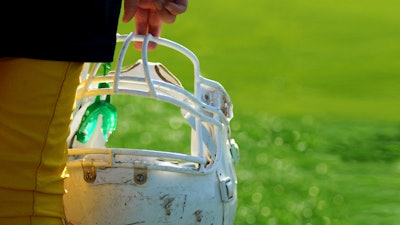
Limiting contact during youth football practices reduces the number of chronic brain problems in high school football players without getting rid of the sport altogether, according to the authors of a new study.
The study, published Thursday in the journal Pediatrics, suggests that a change in the way high schoolers practice may have an even bigger effect than previous approaches meant to restrict head injuries, CNN reported.
The researchers from Indiana University studied games and practices for three high school teams in the Midwest in the 2021 season. They observed practice and studied videos of the teams. Additionally, the players wore mouthguards with sensors in them. They also surveyed the players and parents.
They found that there were 7,312 head impacts among the 74 players: about 66.5 hits per student. Linemen caught the brunt of the head hits. There were the fewest head hits when the kids practiced “air” training, meaning drills without contact.
Football is the most popular sport with high school boys; more than 1.46 million play. Over the years, participation has declined slightly as more parents and children have grown concerned about head injuries and the long-term effects of smashing into each other or the ground.
All 50 states have adopted some sort of concussion rules for schools, and districts have put rules in place to limit head injuries and make football safer. But it’s not just concussions that are a problem. There’s a growing body of evidence showing that chronic sports-related exposure to head impacts, not just in football, can cause microstructural damage and alter or impair some brain activity.
With 5,144 minutes of “air” drills, there were about 310 head impacts overall. In comparison, in 6,901 minutes of “thud” drills, in which players train at high speeds and restrict contact to above the waist, there were 3,360 head impacts.
“The limitation of impact-prone practice drills may reduce overall head-impact exposure,” the study says. “This data are significant because athletes who are diagnosed with a concussion have shown to be exposed to frequent head impacts before the concussive event. This makes a strong case that minimizing head-impact exposure, especially before games, can be done by incorporating less impact-prone drills.”
Dr. Elizabeth Matzkin, chief of women’s sports medicine at Brigham & Women’s Hospital in Boston, works with several high school and Division 1 college football teams. She thinks the suggestion of limited-contact practice is a good one.
“Unfortunately, concussion is a problem, and anything that we can do to limit I think not just concussion – but what part of this article gets to is just head impact, you know, kids falling down, hitting their heads on the ground. Everything adds up,” said Matzkin, who did not work on the study. “How we can modify practices to limit head impacts in our high school football players, it’s a really good place to start.”
Dr. Jeffrey Kutcher, medical director of the Henry Ford Kutcher Clinic for Concussion and Sports Neurology, said this study adds important and specific evidence to back up previous understanding of the sport.
“While this isn’t a new idea or new concept, it definitely provides data that allows us to have stronger conventions about how we design football practice,” said Kutcher, who was not involved in the new research.





































